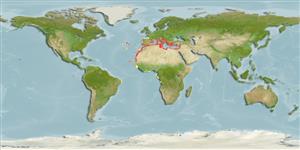Common names from other countries
Classification / Names / Names
Common names | Synonyms | Catalog of Fishes (gen., sp.) | ITIS | CoL | WoRMS
Environment: milieu / climate zone / depth range / distribution range
Ecology
Benthic; depth range 10 - 700 m (Ref. 106272), usually 30 - 150 m (Ref. 435). Subtropical; 46°N - 14°N, 32°W - 36°E
Eastern Atlantic and the Mediterranean: from the Sahara to the coast of Portugal and Israel in the Mediterranean.
Length at first maturity / Size / Weight / Age
Maturity: Lm ? range ? - ? cm Max length : 10.0 cm CL male/unsexed; (Ref. 84401)
Carapace width: 9.2 cm (Ref. 435).
Life cycle and mating behavior
Maturity | Reproduction | Spawning | Eggs | Fecundity | Larvae
Members of the order Decapoda are mostly gonochoric. Mating behavior: Precopulatory courtship ritual is common (through olfactory and tactile cues); usually indirect sperm transfer.
Fischer, W., G. Bianchi and W.B. Scott (eds.). 1981. (Ref. 435)
IUCN Red List Status (Ref. 130435: Version 2024-1)
CITES status (Ref. 108899)
Not Evaluated
Not Evaluated
Human uses
Fisheries: commercial
| FishSource |
Tools
Internet sources
Estimates based on models
Preferred temperature
(Ref.
115969): 13.3 - 19.2, mean 15.4 (based on 212 cells).
Resilience
High, minimum population doubling time less than 15 months (K=0.31).
Vulnerability
Low to moderate vulnerability (30 of 100).
Price category
Unknown.
